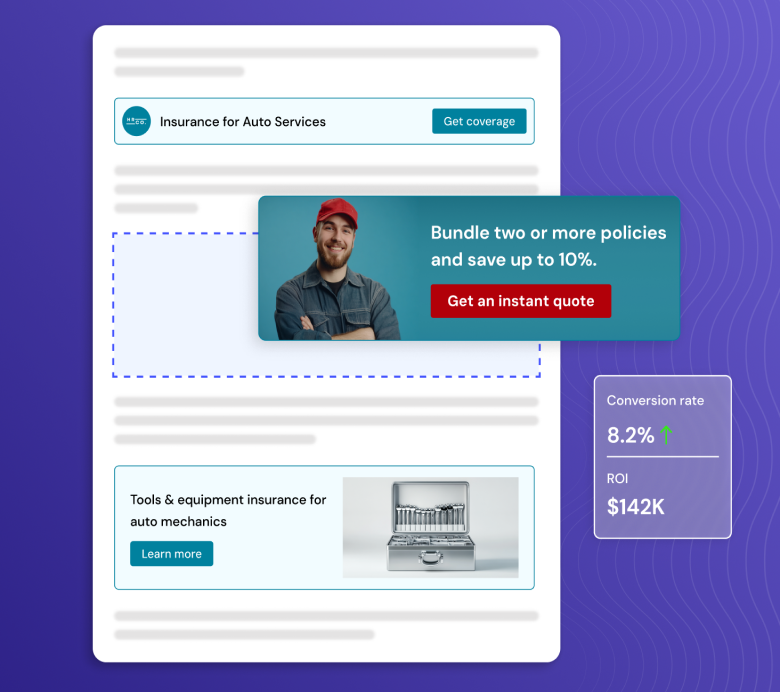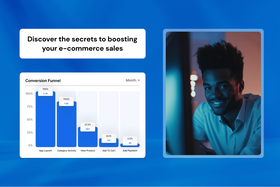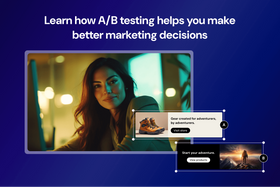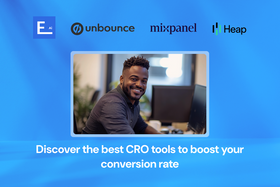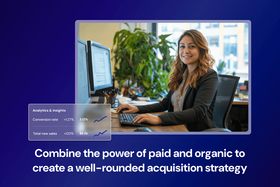SEO conversion rate: How organic traffic turns into customers
This comprehensive guide explains how to calculate, benchmark, and improve SEO conversion rates.
Published May 11, 2025
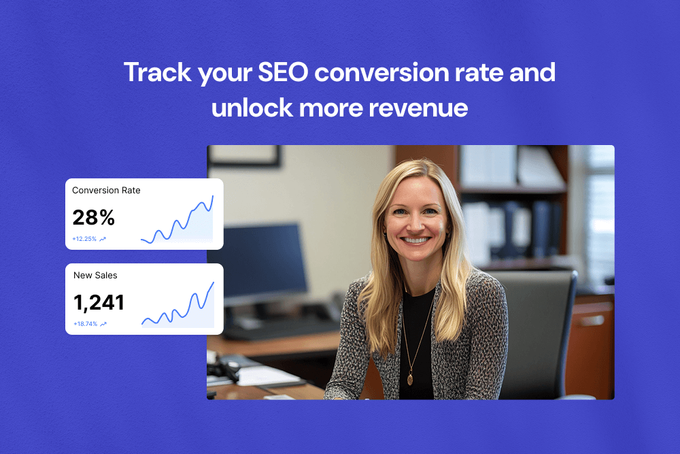
Most websites invest heavily in SEO and content marketing, but many struggle to measure and optimize the actual business impact of these efforts. While marketing teams meticulously track ROI from paid channels, SEO often remains unmeasured due to its complexity. This creates a blind spot in their marketing strategy, despite SEO frequently delivering better long-term returns than any other channel.
In this article, we'll explore how to calculate, benchmark, and improve your SEO conversion rate to maximize the ROI of your organic traffic.
Key takeaways
- SEO conversion rate is key to revenue growth, not just traffic increases.
- Most SEO traffic comes from upper-funnel content that needs proper conversion paths.
- Strategic CTAs that match user intent can increase click-through rates by over 45%.
- Less than 10% of websites effectively convert SEO traffic, but proper attribution and optimization tools make it achievable.
What is SEO conversion rate?
SEO conversion rate measures the percentage of visitors from organic search who complete a desired action on your website. These actions can include:
- Purchasing a product
- Booking a demo or consultation
- Signing up for a newsletter
- Downloading a resource
- Filling out a contact form
- Creating an account
Unlike paid channels, where you can immediately direct traffic to conversion-optimized landing pages, SEO traffic enters your site at various points with different levels of purchase intent. This makes the conversion process more complex but often more cost-effective in the long run.
» Learn more about SEO conversion.
How to calculate SEO conversion rate
The formula for calculating SEO conversion rate is straightforward:
SEO conversion rate = (Number of conversions from organic traffic / Total organic traffic) × 100
For example, if your website received 10,000 organic visitors in a month and generated 300 conversions from that traffic, your SEO conversion rate would be:
(300 / 10,000) × 100 = 3%
You can calculate this using data from Google Analytics, Adobe Analytics, or other analytics platforms that track traffic sources and conversion events.
» Discover the best tool to maximize revenue from your SEO operation.
What is the average SEO conversion rate?
Average SEO conversion rates vary significantly by industry, website type, and the specific conversion action you want to measure. The overall website conversion rates from organic traffic typically fall between 1% and 4%, with the average across all page types sitting at approximately 2.4%.
Average SEO conversion rates by industry
Different industries see varying SEO conversion rates due to purchase complexity, price points, and consumer behavior:
| Industry | Average SEO conversion rate |
|---|---|
| Addiction treatment | 2.1% |
| Biotech | 1.8% |
| B2B SaaS | 2.1% |
| Commercial insurance | 1.7% |
| Construction | 1.9% |
| E-commerce/retail | 1.6% |
| Financial services | 2.2% |
| Higher education and college | 2.4% |
| HVAC services | 3.3% |
| Industrial IOT | 2.2% |
| Legal services | 7.5% |
| Manufacturing and distribution | 3.0% |
| Medical device | 3.1% |
| Oil and gas | 1.7% |
| PCB design and manufacturing | 2.3% |
| Pharmaceutical | 2.0% |
| Real estate | 2.8% |
| Solar energy | 2.7% |
| Transportation and logistics | 1.4% |
Source: First Page Sage
Average SEO conversion rates by page type
The type of page receiving organic traffic also significantly impacts SEO conversion rates:
| Page type | Average SEO conversion rate |
|---|---|
| Product landing page | 2.9% |
| Service landing page | 2.7% |
| Application landing page | 3.1% |
| Location landing page | 1.1% |
| Industry landing page | 1.8% |
| Case study | 3.5% |
| Problem and solution/FAQ page | 2.7% |
| Thought leadership article or blog post | 2.0% |
| Hub page | 0.5% |
| White paper | 4.6% |
Source: First Page Sage
It's important to benchmark your performance against your specific industry and page types rather than general averages. A "good" conversion rate ultimately depends on your business model, customer acquisition costs, and customer lifetime value.
» Find out which conversion metrics you should track in 2026.
7 ways to improve your SEO conversion rate
Conversion rate optimization (CRO) is one of the most effective ways to improve your SEO conversion rate. While SEO increases organic traffic to your site, CRO focuses on turning that traffic into sales.
By applying CRO best practices to your organic traffic, you can significantly increase the ROI of your SEO efforts. Let's look into a few proven CRO tactics that can turn more of your organic traffic into customers.
1. Target bottom-of-the-funnel keywords first
Most SEO operations focus primarily on increasing traffic, but if you want to maximize conversions and ROI, prioritize bottom-of-the-funnel keywords with the highest conversion potential.
For example, if you're selling integrations like Zapier, your lower funnel keywords would include queries about specific integrations like "Gmail Slack integration" or "Monday Trello integration." These searches indicate users are actively looking for solutions you provide and, as a result, are more likely to convert.
Benefits of prioritizing bottom-of-the-funnel keywords:
- They help Google understand what your website offers.
- Users who perform these searches have higher purchase intent.
- Even if rankings are initially low, these pages provide opportunities to guide users closer to conversion using internal linking.
- They form the foundation of your SEO conversion funnel.
Starting with bottom-of-the-funnel keywords ensures you're capturing the most valuable traffic first, then expanding outward to build a complete conversion ecosystem.
Keep in mind that bottom-of-the-funnel keywords will likely have higher competition, as other companies in your industry are also targeting these high-intent searches. However, the conversion potential makes these keywords worth the effort, as they directly relate to what your website offers and can drive immediate business results.
2. Add contextual widgets and CTAs
One of the most effective ways to improve conversion is to optimize your existing content with relevant calls to action. We've found that when users encounter CTAs that directly relate to the content they're reading, click-through rates can exceed 45%.
The key principles for effective contextual CTAs:
- Match the CTA to the specific content section.
- Ensure CTAs reflect user intent and funnel stage.
- Link to the logical next step in the user journey.
- Use multiple CTAs throughout longer content.
- A/B test different CTA formats (links, buttons, widgets).
Instead of generic "Book a Demo" CTAs across all content, tailor them to align with where users are in their journey and guide them to the next logical step. For example, a top-of-the-funnel article like “What is content marketing?” could include CTAs linking to mid-funnel resources like content strategy templates, which in turn could lead users to a product page for a content marketing service.
READ MORE: 20 steal-worthy call-to-action examples that drive results
3. Solve attribution challenges
One of the biggest barriers to improving SEO conversion is properly attributing conversions across multiple touchpoints. Users rarely convert on their first visit, especially with SEO.
Three key attribution scenarios to track:
- First touch: A user lands on your blog from organic search and eventually converts.
- Assist: A user enters your site through another channel, visits blog content during their journey, and then converts.
- Last touch: A user interacts with multiple pages before converting after viewing blog content.
Standard analytics tools struggle with these complex user journeys. To accurately measure SEO's contribution to conversion, you need attribution modeling that tracks users across multiple sessions and pages.
Implementing proper attribution helps you:
- Understand which content drives conversions
- Allocate marketing resources based on actual performance
- Justify continued investment in SEO
- Identify content gaps in your conversion funnel
CRO tools like Entail CRO can help solve these attribution challenges by tracking the contribution of each page to your bottom line.
» Discover everything you need to know about multi-touch attribution.
4. Build supporting content that links to conversion pages
After creating your bottom-of-funnel content, develop supporting content at various funnel stages that strategically links to your conversion pages.
Follow these principles for effective linking:
- Content should primarily link to other pages in the same vertical (topic area).
- Link to content that's either at the same funnel stage or one below.
- Don't link directly from top-of-funnel to bottom-of-funnel content.
- Create clear pathways that guide users through your funnel.
- Ensure each vertical has a complete content ecosystem.
For example, if you sell project management software, your content verticals might include team collaboration, task management, and reporting. Within each vertical, create content that progressively guides users toward conversion, with mid-funnel content linking to bottom-of-the-funnel pages.
» Learn about the 5 stages of the marketing funnel.
5. Use programmatic SEO
For websites with many similar conversion opportunities, programmatic SEO can help scale bottom-of-the-funnel content creation. This approach involves systematically creating templated pages that target specific high-intent keywords.
Zapier provides an excellent example of this strategy. Instead of just targeting "automation tools," they created thousands of specific integration pages (like "Connect Gmail and Slack" or "Connect Trello and HubSpot"). Each page targets a specific integration query with high purchase intent.
Benefits of programmatic SEO for conversion:
- Covers all potential bottom-of-the-funnel keywords
- Reduces content creation costs through automation
- Creates highly targeted pages that match specific user intent
- Scales conversion opportunities across multiple verticals
This approach is particularly effective for e-commerce, directories, marketplaces, and platforms with many similar product or service combinations. Just be sure that each page provides valuable information to keep it from ending up crawled but not indexed.
» Discover how you can simplify conversion rate optimization with AI.
6. Create conversion-focused content types
Beyond standard product and service pages, certain content types perform exceptionally well for SEO conversion:
- Comparison pages ("monday.com vs. Trello")
- "Best of" listicles ("Best project management tools for small teams")
- Alternative pages ("monday.com alternatives")
- Review pages ("monday.com review 2026")
- Solution pages ("monday.com for enterprise")
These high-intent bottom-of-the-funnel pages act as powerful conversion tools by addressing specific user needs at critical decision points. Investing in comprehensive, high-quality versions of these content types for your primary products or services can increase your SEO conversions exponentially.
7. Promote SEO content through other channels
If you've already invested in creating conversion-optimized SEO content, you can maximize its impact by promoting it through additional channels in the following ways:
- Run paid search campaigns to content pages with proven conversion paths
- Promote high-converting blog content through social media
- Include links to conversion-focused content in email marketing campaigns
- Repurpose high-performing blog content for webinars or video content
This approach allows you to:
- Generate additional traffic to conversion-optimized content
- Target upper-funnel keywords with paid ads at lower costs
- Accelerate results while waiting for organic rankings to improve
- Increase the ROI of your content investments
By treating your SEO content as a conversion asset across all channels, you maximize its impact.
Additional SEO conversion metrics to track
While SEO conversion rate provides a high-level view of performance, tracking these other metrics helps you understand what’s really driving organic performance and conversions.
Click-through rate (CTR)
CTR measures how often people click on your link after seeing it in search results. A high CTR means your content is attracting attention. But if conversions are low, it may signal a gap between what users expect and what they find on the page. Together, SEO conversion and CTR help you optimize for both visibility and relevance.
Customer acquisition cost (CAC)
CAC is the total cost of acquiring a new customer. It’s a key metric to track alongside your SEO conversion rate because it shows how efficiently your organic traffic is turning into paying customers. Monitoring both helps you understand how well your SEO is performing and how cost-effective it is.
READ MORE: 8 ways to reduce customer acquisition costs
Customer lifetime value (CLV)
CLV estimates the total revenue a business can expect from a single customer over the entire relationship. Tracking CLV alongside SEO conversion rate helps you evaluate the long-term impact of your SEO efforts—not just whether you're attracting users, but whether you're attracting high-value, loyal customers.
» Find out how to increase CLV.
Return on investment (ROI)
SEO ROI tells you how much revenue your organic search efforts are generating compared to what you’ve spent on them. While SEO conversion rate shows how well your pages perform, ROI shows whether your investment in those pages is actually paying off.
» Learn how to measure SEO ROI.
Engagement rate
Engagement rate measures how actively visitors are using your site—spending time on pages, clicking, scrolling, etc. It's calculated as the ratio of engaged sessions to total sessions.
In Google Analytics, a session is considered "engaged" if it lasts longer than 10 seconds, has a key event, or includes 2+ page views. A good engagement rate typically falls between 60 and 75%, depending on your industry.
Bounce rate
If your SEO conversion rate is low, a high bounce (above 55%) rate might point to a mismatch between search intent and your content, or it could signal issues with page design, load speed, or user experience. Watching both metrics helps you identify where you're losing potential customers in the journey.
Conversion rate for new and returning visitors
Tracking conversion rates separately for new and returning visitors can show how different audience segments interact with your content. New visitors show how well your SEO attracts and converts fresh traffic, while returning visitors highlight how well your site nurtures ongoing interest and moves users closer to a purchase decision.
Turn organic traffic into revenue
If you're not tracking SEO conversions, you're leaving money on the table. Traffic alone won’t grow your business—conversions will. By measuring what matters and optimizing your content for every stage of the funnel, you can turn organic search into one of your highest-performing revenue channels. Start with what you have, track what works, and scale what converts.
» Ready to get more sales from SEO? Book a demo to see Entail CRO in action, or try it for free.
